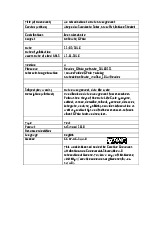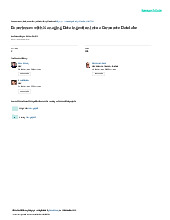Quản trị dữ liệu và trực quan hóa
Danh sách Tài liệu
-
Perception in Visualization| Tài liệu tham khảo môn quản trị dữ liệu và trực quan hóa| Trường Đại học Bách Khoa Hà Nội
278 139 lượt tải 24 trangIntroduction
Human perception plays an important role in the area of visualization. An understanding of perception can significantly im-prove both the quality and the quantity of information being displayed [Ware 2000]. The importance of perception was cit-ed by the NSF panel on graphics and image processing that proposed the term "scientific visualization" [McCormick 87]. The need for perception was again emphasized during a recent DOE/NSF panel on directions for future research in visual-ization [Smith 98].Danh mục: Đại học Bách Khoa Hà NộiMôn: Quản trị dữ liệu và trực quan hóaDạng: Tài liệuTác giả: VietJack1 năm trước -
39 studies about human perception in 30 minutes| Tài liệu tham khảo môn quản trị dữ liệu và trực quan hóa| Trường Đại học Bách Khoa Hà Nội
260 130 lượt tải 36 trangThese are my speaker notes from a talk I gave at OpenVis in April 2016. Originally this talk was supposed to be called “Everything we know about how humans perceive graphics,” which is... at a minimum, pretty pretentious. I scaled back a bit.
Danh mục: Đại học Bách Khoa Hà NộiMôn: Quản trị dữ liệu và trực quan hóaDạng: Tài liệuTác giả: VietJack1 năm trước -
My steps to learn about Apache NiFi| Tài liệu tham khảo môn quản trị dữ liệu và trực quan hóa| Trường Đại học Bách Khoa Hà Nội
413 207 lượt tải 23 trangTable of Contents
Introduction
About this document
About me
Videos with a technical background
Lab 1: Running Apache NiFi inside a Docker container
Prerequisites
Start/Restart
Access to the UI
Status
StopDanh mục: Đại học Bách Khoa Hà NộiMôn: Quản trị dữ liệu và trực quan hóaDạng: Tài liệuTác giả: VietJack1 năm trước -
Text Visualization Browser| Tài liệu tham khảo môn quản trị dữ liệu và trực quan hóa| Trường Đại học Bách Khoa Hà Nội
271 136 lượt tải 3 trangABSTRACT
Text visualization has become a growing and increasingly impor-tant subfield of information visualization. Thus, it is getting harder for researchers to look for related work with specific tasks or visual metaphors in mind. In this poster, we present an interactive visual survey of text visualization techniques that can be used for the pur-poses of search for related work, introduction to the subfield and gaining insight into research trends.
Keywords: Visualization, text visualization, survey, interaction, web-based systemsDanh mục: Đại học Bách Khoa Hà NộiMôn: Quản trị dữ liệu và trực quan hóaDạng: Tài liệuTác giả: VietJack1 năm trước -
Data Warehouse and OLAP| Tài liệu tham khảo môn quản trị dữ liệu và trực quan hóa| Trường Đại học Bách Khoa Hà Nội
342 171 lượt tải 31 trangWhat is Data Warehouse What is Data Warehouse? (1)
• A data warehouse is a repository of information collected from multiple sources, stored under a unified schema, and that usually resides at a single siteDanh mục: Đại học Bách Khoa Hà NộiMôn: Quản trị dữ liệu và trực quan hóaDạng: Tài liệuTác giả: VietJack1 năm trước -
Data Lakes Purposes, Practices, Patterns, and Platforms| Tài liệu tham khảo môn quản trị dữ liệu và trực quan hóa| Trường Đại học Bách Khoa Hà Nội
227 114 lượt tải 42 trangIntroduction to Data Lakes
We’re experiencing a time of great change as data evolves into greater diversity (more data types, sources, schema, and latencies) and as user organizations diversify the ways they use data for business value (via advanced analytics and data integrated across multiple analytics and operational applications). To capture new big data, to scale up burgeoning traditional data, and to leverage both fully, users are modernizing their portfolios of tools, platforms, best practices, and skills.Danh mục: Đại học Bách Khoa Hà NộiMôn: Quản trị dữ liệu và trực quan hóaDạng: Tài liệuTác giả: VietJack1 năm trước -
An Introduction to Data Management| Tài liệu tham khảo môn quản trị dữ liệu và trực quan hóa| Trường Đại học Bách Khoa Hà Nội
239 120 lượt tải 54 trangWhat is Data Management?
Data management concerns the dealing with data in the scientific context. Often, more importance is given to results, analysis and derived conclusion than to the data themselves. However, data are a product of the science enterprise and are more and more understood as a valuable research output themselves (DataONE 2012b; Ludwig and Enke 2013; Data Service 2012-2015a). Research data are considered all
information collected, observed or created for purposes of analysis and validation of original research results. Data can be quantitative or qualitative and comprises also photos, objects or audio files, resulting from as different sources as field experiments, model outputs or satellite data. In the following, the focus lies on the management of quantitative digital data.Danh mục: Đại học Bách Khoa Hà NộiMôn: Quản trị dữ liệu và trực quan hóaDạng: Tài liệuTác giả: VietJack1 năm trước -
Programming, Data Management and Visualization| Tài liệu tham khảo môn quản trị dữ liệu và trực quan hóa| Trường Đại học Bách Khoa Hà Nội
513 257 lượt tải 4 trang1. GOALS
In this class you will learn advanced concepts in programming and data management using the statistical software package Stata. We focus on Stata because almost all subsequent courses in the econometrics curriculum use this software. However, note that many topics we cover are highly relevant for any statistical programming suite, even though the commands and concepts may differ slightly. However, Stata is not object-oriented as most other common languages, such
as R or Python, but rather procedural or function-oriented (which makes it also much easier to learn). Upon successful completion, you are capable to handle Stata and understand data management at a level required for the subsequent courses in the JKU econometrics curriculum.Danh mục: Đại học Bách Khoa Hà NộiMôn: Quản trị dữ liệu và trực quan hóaDạng: Tài liệuTác giả: VietJack1 năm trước -
Experiences with Managing Data Ingestion into a Corporate Datalake| Tài liệu tham khảo môn quản trị dữ liệu và trực quan hóa| Trường Đại học Bách Khoa Hà Nội
257 129 lượt tải 10 trangINTRODUCTION
The Hadoop Distributed File System (HDFS) [1] is an
inexpensive means of aggregating storage from commodity
machines across a cluster. It has been shown to scale to
petabytes of data [2] allowing organizations to store and
process data at a scale that had not previously been feasible
without very expensive dedicated systems. This has led to the
concept of a Datalake where a company can store their raw
data in such a way that it could be governed by one set of
policies but processed by multiple different teams [3], [4].Danh mục: Đại học Bách Khoa Hà NộiMôn: Quản trị dữ liệu và trực quan hóaDạng: Tài liệuTác giả: VietJack1 năm trước -
Data Lake Management: Challenges and Opportunities| Tài liệu tham khảo môn quản trị dữ liệu và trực quan hóa| Trường Đại học Bách Khoa Hà Nội
230 115 lượt tải 4 trangINTRODUCTION
A data lake is a massive collection of datasets that: (1)
may be hosted in different storage systems; (2) may vary
in their formats; (3) may not be accompanied by any use-ful metadata or may use different formats to describe their
metadata; and (4) may change autonomously over time. En-terprises have embraced data lakes for a variety of reasons.
First, data lakes decouple data producers (for example, op-erational systems) from data consumers (such as, reporting
and predictive analytics systems). This is important, espe-cially when the operational systems are legacy mainframes
which may not even be owned by the enterprise (as is com-mon in many enterprises such as banking and finance). For
data science, data lakes provide a convenient storage layer
for experimental data, both the input and output of data
analysis and learning tasks. The creation and use of data
can be done autonomously without coordination with other
programs or analysts. But the shared storage of a data lake
coupled with a (typically distributed) computational frame-work, provides the rudimentary infrastructure required for
sharing and re-use of massive datasets.Danh mục: Đại học Bách Khoa Hà NộiMôn: Quản trị dữ liệu và trực quan hóaDạng: Tài liệuTác giả: VietJack1 năm trước









